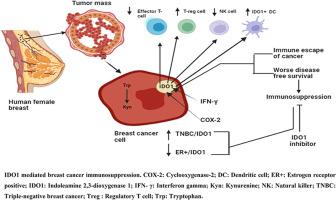Role of indoleamine 2, 3-dioxygenase 1 in immunosuppression of breast cancer
IF 2.8
引用次数: 0
Abstract
Breast cancer (BC) contributes greatly to global cancer incidence and is the main cause of cancer-related deaths among women globally. It is a complex disease characterized by numerous subtypes with distinct clinical manifestations. Immune checkpoint inhibitors (ICIs) are not effective in all patients and have been associated with tumor resistance and immunosuppression. Because amino acid (AA)-catabolizing enzymes have been shown to regulate immunosuppressive effects, this review investigated the immunosuppressive roles of indoleamine 2,3-dioxygenase 1 (IDO1), a tryptophan (Trp)-catabolizing enzyme, which is overexpressed in various metastatic tumors. It promotes immunomodulatory effects by depleting Trp in the regional microenvironment. This leads to a reduction in the number of immunogenic immune cells, such as effector T and natural killer (NK) cells, and an increase in tolerogenic immune cells, such as regulatory T (Treg) cells. The BC tumor microenvironment (TME) establishes a supportive niche where cancer cells can interact with immune cells and neighboring endothelial cells and is thus a feasible target for cancer therapy. In many immunological contexts, IDO1 regulates immune control by causing regional metabolic changes in the TME and tissue environment, which may further affect the maturation of systemic immunological tolerance. In the development of effective treatment targets and approaches, it is essential to understand the immunomodulatory effects exerted by AA-catabolizing enzymes, such as IDO1, on the components of the TME.

吲哚胺 2,3-二氧合酶 1 在乳腺癌免疫抑制中的作用
乳腺癌(BC)在全球癌症发病率中占很大比例,是全球妇女因癌症死亡的主要原因。乳腺癌是一种复杂的疾病,有许多亚型,临床表现各不相同。免疫检查点抑制剂(ICIs)并非对所有患者都有效,而且与肿瘤耐药性和免疫抑制有关。由于氨基酸(AA)分解酶已被证明可调节免疫抑制效应,本综述研究了吲哚胺 2,3-二氧合酶 1(IDO1)的免疫抑制作用,IDO1 是一种色氨酸(Trp)分解酶,在各种转移性肿瘤中过度表达。它通过消耗区域微环境中的 Trp 来促进免疫调节作用。这会导致免疫原性免疫细胞(如效应 T 细胞和自然杀伤(NK)细胞)数量减少,而耐受性免疫细胞(如调节性 T(Treg)细胞)数量增加。BC 肿瘤微环境(TME)建立了一个支持性龛位,癌细胞可在此与免疫细胞和邻近的内皮细胞相互作用,因此是癌症治疗的一个可行靶点。在许多免疫学背景下,IDO1 通过引起 TME 和组织环境的区域代谢变化来调节免疫控制,这可能会进一步影响全身免疫耐受的成熟。在开发有效治疗靶点和方法的过程中,了解 AA 分解酶(如 IDO1)对 TME 组成部分的免疫调节作用至关重要。
本文章由计算机程序翻译,如有差异,请以英文原文为准。
求助全文
约1分钟内获得全文
求助全文
来源期刊

Cancer pathogenesis and therapy
Surgery, Radiology and Imaging, Cancer Research, Oncology
CiteScore
0.80
自引率
0.00%
发文量
0
审稿时长
54 days
 求助内容:
求助内容: 应助结果提醒方式:
应助结果提醒方式:


